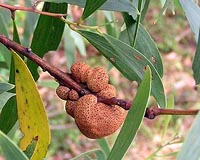| . |  |
. |
Waco TX (SPX) Nov 11, 2009 Baylor University researchers have identified a key component that increases the toxicity of golden algae (Prymnesium parvum), which kills millions of fish in the southern U.S. every year. The Baylor study is the first to determine what makes the deadly golden algae more potent in inland waters. The results have been published the journal Toxicon. While golden algae is primarily a coastal species, it has been found in Texas rivers and lakes, including Lake Whitney and Lake Waco in Central Texas, and Lake Granbury in North Texas. Experts understand that several environmental factors influence toxin production, but now new research from Baylor scientists shows that once the toxin is released into the water, its propensity to cause harm to the environment is influenced by the lake's pH level. In fact, the toxins become more potent at higher pH, which the Baylor researchers say is interesting because blooms may actually increase pH. The Baylor researchers examined the pH and toxicity of several lakes in central and north Texas known for large golden algae fish kills. They also performed laboratory experiments to confirm observations in the field and used computational models to examine physicochemical properties of golden algae toxins at various pH. They found that as the pH level in the lakes increased so did the toxicity of the algae. In fact, the potency of the algae was nearly five times greater at a pH level of 8.5 than it was at 6.5. "These results suggest that at least some of the identified toxins released by golden algae are weak bases. Consequently, in-reservoir pH may substantially influence their availablity, fate, and ultimately their toxicity," said Ted Valenti, a Baylor doctoral student who was lead author on the article, which resulted from a study funded by Texas Parks and Wildlife Department and the U.S Environmental Protection Agency to Dr. Bryan Brooks, associate professor of environmental sciences at Baylor. "The continuation of monitoring efforts coupled with further investigation of climate and land-use patterns is critical. This interdisciplinary approach may allow researchers to better understand bloom formation and pH dynamics in reservoirs, which may allow them to better predict and mitigate fish kills in the future." Along the Brazos River in north and central Texas, more than 6 million fish have been killed since 1988 due to high golden algae levels, according to Texas Parks and Wildlife. In fact, just two years ago, thousands of dead fish washed up on the shores of Lake Whitney. But this was a small incident in comparison to a similar event in 2005, when more than a million fish died in the lake over a three-month period. Officials believe large golden algae blooms contributed to the deaths, attacking the fishes' gills and causing them to suffocate. The Baylor researchers worked in collaboration with Dr. Daniel Roelke at Texas A and M University and Drs. James Grover and Kevin Schug at the University of Texas at Arlington.
Share This Article With Planet Earth
Related Links Baylor University Darwin Today At TerraDaily.com
 Ants can attack trees to make housing
Ants can attack trees to make housingNorwich, England (UPI) Nov 10, 2009 Plant ants generally live in harmony with their hosts, but a British-Brazilian study finds that when the ants run out of space they can become destructive. The research led by Douglas Yu of the University of East Anglia and Glenn Shepard of Sao Paulo University is said to be the first to document that ants bore into live trees. Scientists said ants and certain species of plants ... read more |
|
| The content herein, unless otherwise known to be public domain, are Copyright 1995-2009 - SpaceDaily. AFP and UPI Wire Stories are copyright Agence France-Presse and United Press International. ESA Portal Reports are copyright European Space Agency. All NASA sourced material is public domain. Additional copyrights may apply in whole or part to other bona fide parties. Advertising does not imply endorsement,agreement or approval of any opinions, statements or information provided by SpaceDaily on any Web page published or hosted by SpaceDaily. Privacy Statement |